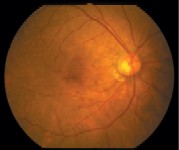Editors note: This month, we welcome Dr. Hoscheit to our roster of columnists. Dr. Hoscheit, a private practitioner in Gastonia, N.C., has published and lectured frequently on numerous topics, including ocular pharmacology.
With the publishing of the Age Related Eye Disease Study, better known as AREDS, last October,1 you can expect patients to ask you whether they should take vitamins for their eyes. Theyll expect you to offer them some answers.
This seven-year, multi-center study looked at more than 4,000 patients with early, intermediate and advanced age-related macular degeneration. Researchers concluded that high levels of antioxidants and zinc significantly reduce their risk of advanced AMD.
If we follow the studys recommendations, we would tell patients 55 and older who are at high risk of developing advanced AMD (categories 3 and 4) to consider taking a combination of antioxidants and zinc.
We would also encourage everyone older than 55 to have a dilated eye examination to determine their risk of developing advanced AMD.
However, we must educate patients about what impact supplements had on vision when recommending the AREDS formula. This formula consisted of vitamins C (500 mg), E (400 IU) and A (15mg in the form of beta carotene); zinc (80mg zinc oxide); and copper (2mg cupric oxide). Patients must understand that this formula does not cure AMD, nor does it guarantee specific visual outcomes.

Would nutritional supplements help this AMD patient? The Age-Related Eye Disease Study offers some answers, but there are several factors to consider.
What AREDS does tell us, though, is that patients who are at high risk of developing advanced stages of AMD lowered their risk by about 25% when treated with this specific formula. In addition, patients who have intermediate or advanced AMD in one eye only lowered their risk of vision loss by about 19%.
Risks vs. Rewards
Besides determining a patients AMD category (see table), we must consider the risks as well, and take a thorough history.
The AREDS formula is contraindicated in smokers or former smokers, because beta-carotene increases their risk of lung cancer. Previously, patients were advised to take zinc alone or zinc plus vitamins E and C. There also are formulations, such as VisiVite Smokers Formula, which substitutes lutein for beta-carotene.
Of the ingredients that were investigated as part of AREDS formula, zinc probably raises the most red flags. There are several reasons for this:
More than 75mg daily zinc can cause copper-deficiency anemia. (Thus, the AREDS formulation included copper, and patients were monitored for anemia.)
Zinc can also increase the frequency of urinary tract infections, kidney stones and prostatic hypertrophy.
Less common side effects of 75mg or more of zinc per day can include gastrointestinal irritation, vomiting, adverse cholesterol changes that could lead to atherosclerosis, impaired immunity, nausea and fever.
Zinc has been loosely associated with Alzheimers disease, but there is not enough evidence to contraindicate zinc in patients with moderate or severe AMD.
The other supplements, even in amounts greater than the recommended daily allowances, dont carry as much risk at the levels in the AREDS formulation.
New Since AREDS
Categories
Characteristics of AMD
1
No AMD; few (fewer than five) or small (smaller than 63) drusen, and acuity of 20/32 or better in both eyes.
2
Mild AMD; multiple small drusen or medium-sized (63-124 ) drusen in one or both eyes, or pigment abnormalities and visual acuity of 20/32 or better in both eyes.
3
At least one eye with visual acuity of 20/32 or better with at least one large (greater than125) drusen, extensive intermediate drusen, absence of geographic atrophy in the center of the macula, or any combination of these.
4
Advanced AMD or visual acuity less than 20/32 in one eye with the AMD abnormalities as the cause of that reduced vision, and the other eye with acuity of 20/32 or better.
We now know that other additives, namely the photonutrients, also play a role in preventing visual loss to AMD. One such additive: lutein, the primary carotenoid in the eye.
Lutein was not commercially available when AREDS was initiated, but other studies offer some clues to its effectiveness. But at least one study has found that AMD was almost twice as prevalent in subjects with low lutein and antioxidant intake vs. patients with high intake. They also found a relationship between the dose and effects.
Opinions vary about how much lutein patients should take. Some clinicians recommend at least 12mg daily (the equivalent of four large salad bowls of spinach).2 Others believe patients with wet or dry AMD should take 6mg of lutein daily for several months and then lower the dose 2 mg daily.
Another nutrient worth looking at: DHA (docosahexaenoic acid). This omega-3 fatty acid is found in oily fish such as tuna, mackerel and salmon. DHA is part of every cell membrane in the body, including the retinal photoreceptors. Some clinicians recommend that patients with AMD take 500mg of DHA daily.2
Whether patients take the AREDS formula, or supplements of lutein or DHA, they would do best to take them with food. This is especially helpful for vitamin E, lutein and DHA, all of which are fat soluble. Also, remind patients to follow label directions carefully, and to not take higher doses than recommended.
As patients hear more about vitamins, particularly those intended to promote eye health, you can expect them to ask questions. You need to keep abreast of the latest research so that you can guide them on the appropriate use and possibly offset vision loss later.
1. Age-Related Eye Disease Study Group. A randomized, placebo-controlled, clinical trial of high-dose supplementation with vitamins C and E, beta carotene, and zinc for age-related macular degeneration and vision loss: AREDS report no. 8. Arch Ophthalmol 2001 Oct;119(10):1417-36.
2. Warnock S. Researchers continue to find nutritions value in preventing and even treating AMD. Primary Care Optometry News 2001 Aug;6(8):27-8.

